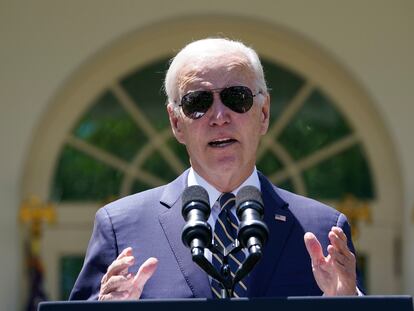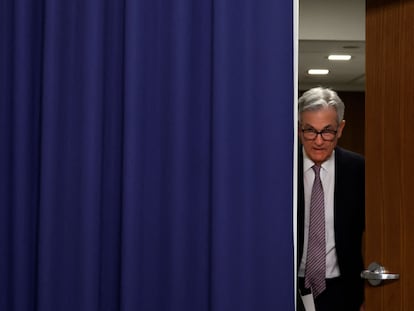The IMF urges United States to seek definitive solution to debt ceiling crisis
The international agency foresees high interest rates until the end of 2024 due to persistent inflation and a resilient economy


History has a way of repeating itself. The U.S. Treasury has reached the authorized debt limit and political parties are negotiating a solution against the clock. Uncertainty and the specter of a possible default is generating instability in the markets and weighing down the economy. The International Monetary Fund (IMF) on Friday requested an immediate solution to the pressing problem, but also a permanent remedy so that the debt crisis does not become a recurring issue.
After meeting with U.S. Treasury Secretary Janet Yellen and with Federal Reserve Chair Jerome Powell, IMF managing director Kristalina Georgieva insisted in a news conference about the need to find a solution.
“Getting a good result is paramount from a global perspective. The U.S. Treasury market is the anchor of stability for the global financial system. And this anchor needs to stay strong. You pull the anchor and the world economy – the ship on which we all travel – is in choppy, and, even worse, uncharted waters,” she said. “So at a time of significant uncertainty, let’s not add a self-inflicted wound to those already suffered by the global economy. There is some encouraging news that the discussions are moving forward. But the world is watching and the world is saying, ‘Okay, let’s close this. And please, can you come up with a different way of approaching this issue?”
According to the IMF, tensions over the federal debt ceiling could create additional, entirely avoidable systemic risk to both the U.S. and global economies, at a time when visible tensions already exist. To avoid exacerbating downside risks, Congress should immediately raise or entirely suspend the debt ceiling, allowing negotiations on the fiscal 2024 budget to begin in earnest, the organization believes.
Persistent inflation
The IMF has raised the growth forecast for the United States by one tenth of a percentage point for this year to 1.7%, and lowered next year’s by one tenth to 1%, compared to the April forecasts. Its experts underscored that the economy has shown resilience to the significant tightening of fiscal and monetary policy that took place in 2022 and has avoided recession so far. “Consumer demand has held up particularly well, boosted initially by a drawdown of pent-up savings and, more recently, by solid growth in real disposable incomes,” said the IMF.
The other side of the coin is that inflation refuses to subside and will remain “substantially above” the 2% target this year and next, the IMF estimates. “To bring inflation firmly back to target will require an extended period of tight monetary policy, with the federal funds rate remaining at 5¼–5½ percent until late in 2024,”said the IMF. These are higher interest rates for longer than the market currently expects.
The IMF also warned that the rapid rise in interest rates may not be enough to bring inflation back to target quickly. “With a large share of household and corporate debt contracted at relatively long duration and fixed rates, household consumption and corporate investment have proven less interest-sensitive than in past tightening cycles,” said the IMF.
Recession risk
This creates a significant risk that the Fed will have to raise the policy rate by significantly more than is currently expected to return inflation to 2%. The IMF believes that near-term growth outcomes could be better than currently anticipated. “However, this would only mean that the economy would slow more abruptly at a later stage (possibly in 2024), creating a recession as tighter monetary policy takes hold,” said the organization. “The combination of higher U.S. interest rates, a stronger dollar, and a sharper slowdown in U.S. activity would have significant negative macro-financial spillovers to the rest of the world.”
In addition, a more aggressive increase in interest rates could reveal more serious and systemic problems than those observed to date in the balance sheets of banks, non-bank entities and companies, according to the IMF, which believes that “a tightening of financial conditions could trigger an increase in bankruptcies, worsen credit quality, and heighten stress for those entities carrying high levels of leverage and with large near-term gross financing needs.”
Tax adjustment
The IMF also warned that the United States needs a fiscal adjustment to reach a more sustainable level of debt. “Beyond the near-term need for fiscal tightening, a more significant adjustment (i.e., an increase of around 5 percent of GDP in the general government primary balance) is required to put public debt on a decisively downward path by the end of this decade,” it said. However, the IMF believes that precluding increases in the taxation of those earning under $400,000 per year or changes to social security and Medicare will ultimately make such an adjustment infeasible.
There are several formulas to reduce the deficit by way of tax collection and the IMF has a few ideas. leaves a wide menu of proposals: “Revenues could be increased through a broad-based federal consumption tax, a carbon tax, higher taxation of corporates and high-income individuals, scaling back poorly targeted tax expenditures (such as for employer-provided health care, sale of the principal residence, mortgage interest, and state and local taxes), closing tax loopholes, reducing the minimum threshold for the estate tax, and further improving revenue administration.”
Finally, the IMF encouraged the United States to make more efforts in the fight against climate change and criticized its protectionist policy: “The Inflation Reduction Act, the CHIPS Act, and the Build America, Buy America Act have included provisions that are explicitly designed to favor goods and services produced in the U.S. or in North America. We know from experience that protectionist provisions distort trade and investment and risk creating a slippery slope that will fragment global supply chains and trigger retaliatory actions by trading partners.”
Sign up for our weekly newsletter to get more English-language news coverage from EL PAÍS USA Edition
Tu suscripción se está usando en otro dispositivo
¿Quieres añadir otro usuario a tu suscripción?
Si continúas leyendo en este dispositivo, no se podrá leer en el otro.
FlechaTu suscripción se está usando en otro dispositivo y solo puedes acceder a EL PAÍS desde un dispositivo a la vez.
Si quieres compartir tu cuenta, cambia tu suscripción a la modalidad Premium, así podrás añadir otro usuario. Cada uno accederá con su propia cuenta de email, lo que os permitirá personalizar vuestra experiencia en EL PAÍS.
¿Tienes una suscripción de empresa? Accede aquí para contratar más cuentas.
En el caso de no saber quién está usando tu cuenta, te recomendamos cambiar tu contraseña aquí.
Si decides continuar compartiendo tu cuenta, este mensaje se mostrará en tu dispositivo y en el de la otra persona que está usando tu cuenta de forma indefinida, afectando a tu experiencia de lectura. Puedes consultar aquí los términos y condiciones de la suscripción digital.
More information
Archived In
Últimas noticias
Most viewed
- Sinaloa Cartel war is taking its toll on Los Chapitos
- Oona Chaplin: ‘I told James Cameron that I was living in a treehouse and starting a permaculture project with a friend’
- Reinhard Genzel, Nobel laureate in physics: ‘One-minute videos will never give you the truth’
- Why the price of coffee has skyrocketed: from Brazilian plantations to specialty coffee houses
- Silver prices are going crazy: This is what’s fueling the rally










































